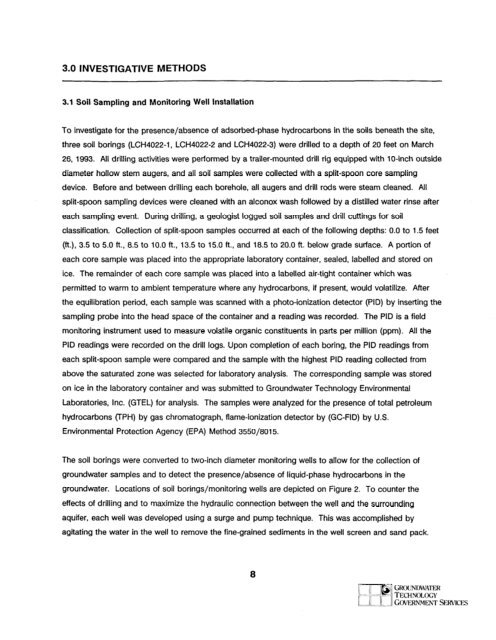three well site check bldg lch-4022
three well site check bldg lch-4022
three well site check bldg lch-4022
You also want an ePaper? Increase the reach of your titles
YUMPU automatically turns print PDFs into web optimized ePapers that Google loves.
3.0 INVESTIGATIVE METHODS3.1 Soil Sampling and Monitoring Well InstallationTo investigate for the presence/absence of adsorbed-phase hydrocarbons in the soils beneath the <strong>site</strong>,<strong>three</strong> soil borings (LCH<strong>4022</strong>-1, LCH<strong>4022</strong>-2 and LCH<strong>4022</strong>-3) were drilled to a depth of 20 feet on March26, 1993. All drilling activities were performed by a trailer-mounted drill rig equipped with lo-inch outsidediameter hollow stem augers, and all soil samples were collected with a split-spoon core samplingdevice. Before and between drilling each borehole, all augers and drill rods were steam cleaned. Allsplit-spoon sampling devices were cleaned with an alconox wash followed by a distilled water rinse aftereach sampling event. During drilling, a geologist logged soil samples and drill cuttings for soilclassification. Collection of split-spoon samples occurred at each of the following depths: 0.0 to 1.5 feet(ft.), 3.5 to 5.0 ft., 8.5 to 10.0 ft., 13.5 to 15.0 ft., and 18.5 to 20.0 ft. below grade surface. A portion ofeach core sample was placed into the appropriate laboratory container, sealed, labelled and stored onice. The remainder of each core sample was placed into a labelled air-tight container which waspermitted to warm to ambient temperature where any hydrocarbons, if present, would volatilize. Afterthe equilibration period, each sample was scanned with a photo-ionization detector (PID) by inserting thesampling probe into the head space of the container and a reading was recorded. The PID is a fieldmonitoring instrument used to measure volatile organic constituents in parts per million (ppm). All thePID readings were recorded on the drill logs. Upon completion of each boring, the PID readings fromeach split-spoon sample were compared and the sample with the highest PID reading collected fromabove the saturated zone was selected for laboratory analysis. The corresponding sample was storedon ice in the laboratory container and was submitted to Groundwater Technology EnvironmentalLaboratories, Inc. (GTEL) for analysis. The samples were analyzed for the presence of total petroleumhydrocarbons (TPH) by gas chromatograph, flame-ionization detector by (GC-FID) by U.S.Environmental Protection Agency (EPA) Method 3550/8015.The soil borings were converted to two-inch diameter monitoring <strong>well</strong>s to allow for the collection ofgroundwater samples and to detect the presence/absence of liquid-phase hydrocarbons in thegroundwater. Locations of soil borings/monitoring <strong>well</strong>s are depicted on Figure 2. To counter theeffects of drilling and to maximize the hydraulic connection between the <strong>well</strong> and the surroundingaquifer, each <strong>well</strong> was developed using a surge and pump technique. This was accomplished byagitating the water in the <strong>well</strong> to remove the fine-grained sediments in the <strong>well</strong> screen and sand pack.8
















